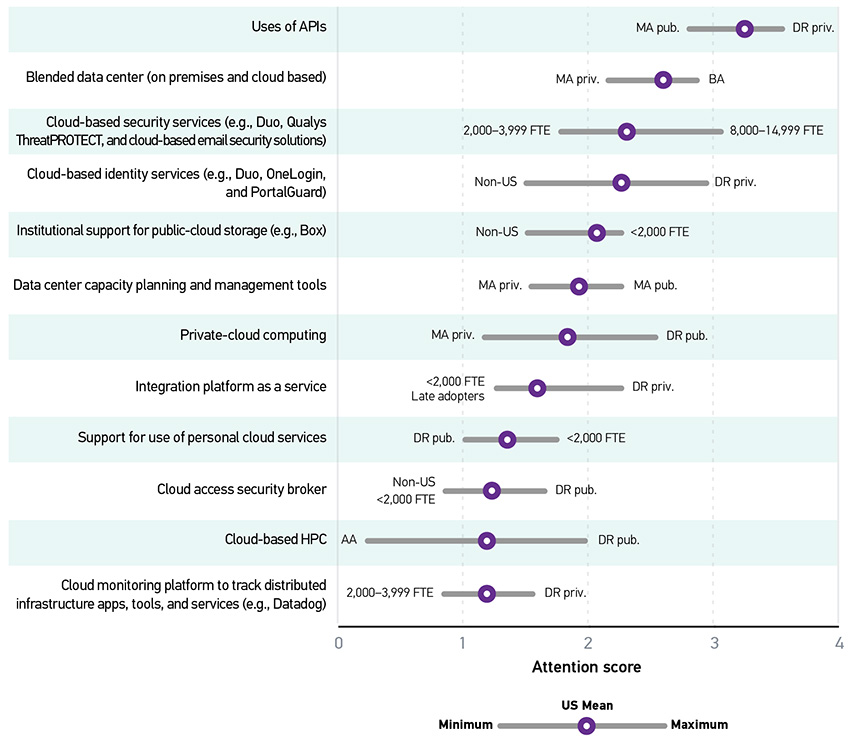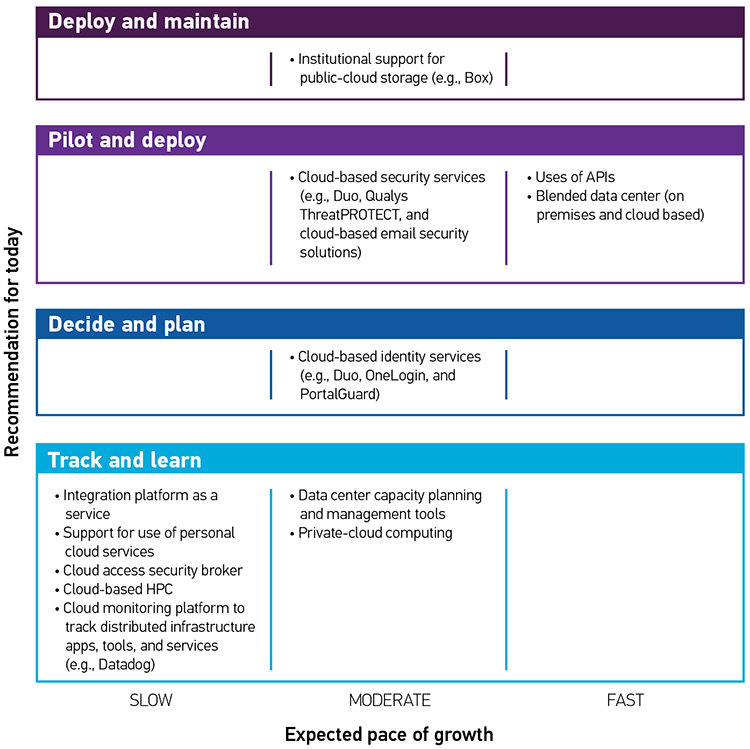Cloud Technologies
From 2004 to 2014, cloud computing service delivery issues were clearly reflected every year on the EDUCAUSE Top 10 IT issues list. Cloud technology was considered a novelty and a developing technology during that decade, and research and writings pondered the strategic and technological issues related to whether campus departments could or should move institutional IT services to the cloud. Fast forward to 2018, where the words ubiquitous and cloud occur in the same sentence so frequently that we have grown immune to the true novelty and potential that cloud technologies once represented. Institutions are no longer considering discrete cloud computing options but instead are incorporating cloud approaches into their entire service delivery strategy, from services offered to end users to specialized research services to services used exclusively within the purview of the IT department.
This section covers the 12 trends and 12 technologies included in the cloud domain. Institutional adoption of cloud technologies is heavily influenced by the increasing complexity of today's IT environment. Like other domains covered in this report, this trend of complexity, and institutional responses to the trend, foretell a time of digital transformation.
Trends
Included in this domain:
- Bimodal IT
- Business process redesign
- Changing enterprise system architectures, integrations, and workflows
- Contributions of IT to institutional operational excellence
- Cross-institutional partnerships and consortia
- DevOps movement
- Incorporating open standards into enterprise IT architecture
- Incorporating risk-management approaches into IT strategy and service delivery
- Increasing complexity of technology, architecture, and data
- Institution-wide data management and integrations
- National and global political uncertainty
- Strategic relationships with vendors
Understand how the most influential trends are affecting your institution.
Two trends are influential at 61% or more of colleges and universities (listed below from highest to lowest level of influence):
- Contributions of IT to institutional operational excellence
- Increasing complexity of technology, architecture, and data
Review the trends that are taking hold and address them at your institution.
Five trends are influential at 41–60% of institutions (listed below from highest to lowest level of influence):
- Institution-wide data management and integrations
- Business process redesign
- Changing enterprise system architectures, integrations, and workflows
- Strategic relationships with vendors
- Incorporating risk-management approaches into IT strategy and service delivery
Understand these trends, and consider their possible role at your institution.
The influence of two trends is limited to 21–40% of institutions. Higher education is monitoring these trends with respect to emerging IT strategy and the deployment of cloud strategic technologies (listed below from highest to lowest level of influence):
- Cross-institutional partnerships and consortia
- Incorporating open standards into enterprise IT architecture
The remaining three trends were of limited impact in our research:
- Bimodal IT
- DevOps movement
- National and global political uncertainty
Technologies
Included in this domain:
- Blended data center (on premises and cloud based)
- Cloud access security broker
- Cloud monitoring platform to track distributed infrastructure apps, tools, and services (e.g., Datadog)
- Cloud-based HPC
- Cloud-based identity services (e.g., Duo, OneLogin, and PortalGuard)
- Cloud-based security services (e.g., Duo, Qualys ThreatPROTECT, and cloud-based e-mail security solutions)
- Data center capacity planning and management tools
- Institutional support for public-cloud storage (e.g., Box)
- Integration platform as a service
- Private-cloud computing
- Support for use of personal cloud services
- Uses of APIs
Complete initial deployment and maintain these technologies.
Our research shows that about half of institutions are planning to deploy and maintain this cloud strategic technology:
- Institutional support for public-cloud storage (e.g., Box)
Pilot and start deploying these technologies.
At this time, about one-half to two-thirds of institutions are planning to pilot and deploy these three cloud strategic technologies (listed below from highest to lowest attention):
- Uses of APIs
- Blended data center (on premises and cloud based)
- Cloud-based security services (e.g., Duo, Qualys ThreatPROTECT, and cloud-based e-mail security solutions)
Decide when these technologies fit your strategy, and start planning.
Almost half of institutions are watching this cloud strategic technology carefully, deciding and planning for potential future deployment:
- Cloud-based identity services (e.g., Duo, OneLogin, and PortalGuard)
Learn about and track these technologies.
About one-half to two-thirds of institutions are tracking and learning about the following seven cloud strategic technologies (listed below from highest to lowest attention):
- Data center capacity planning and management tools
- Private-cloud computing
- Integration platform as a service
- Support for use of personal cloud services
- Cloud access security broker
- Cloud-based HPC
- Cloud monitoring platform to track distributed infrastructure apps, tools, and services (e.g., Datadog)
Peer Institution Approach to Strategic Technologies
Understanding what peer institutions (both current and aspirational) are doing can help you gauge whether your institution's current approach is on track or might warrant reconsideration. Some technologies are more relevant for some types of institutions than others. We looked at broad demographic categories, including Carnegie class, institutional size, and approach to technology adoption and found differences in attention score based on those factors. (See the methodology section for explanation of our attention score calculation.) In figure 3, the US mean is the average attention score for an item from all US respondents. The minimums and maximums are the lowest and highest average attention scores among all groups within the categories of Carnegie class, institution size, and timing of technology adoption, with labels indicating which group or groups returned that score. In the event of a tie, all tied groups are represented.

Preparing for the Future
Understanding the technologies that are most relevant for your institution and how fast a certain strategic technology may be growing is critical to institutional IT strategy. We estimated the pace of growth based on the percentage of institutions we predict will implement each technology over the next five years (by 2023). Figure 4 positions each technology in one of 12 cells based on institutional intentions (the "recommendation for today") and the expected pace of growth of that technology. Reflecting what was noted above, the figure shows that institutions continue to track and learn about a number of technologies, with only a few of technologies on the fast-track to reaching the pilot, deploy, and maintain stages.
